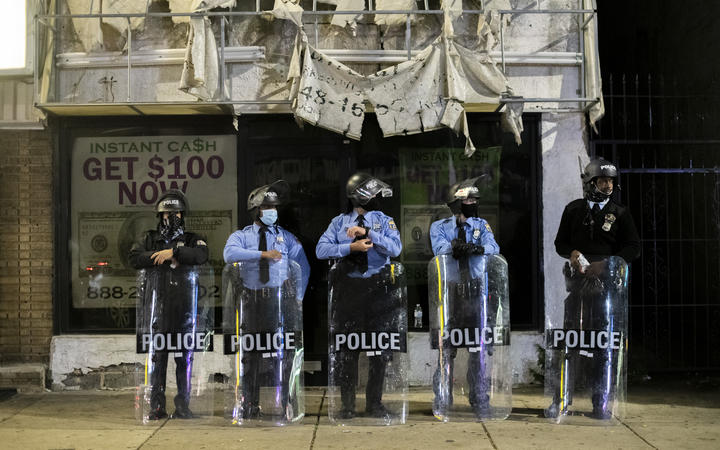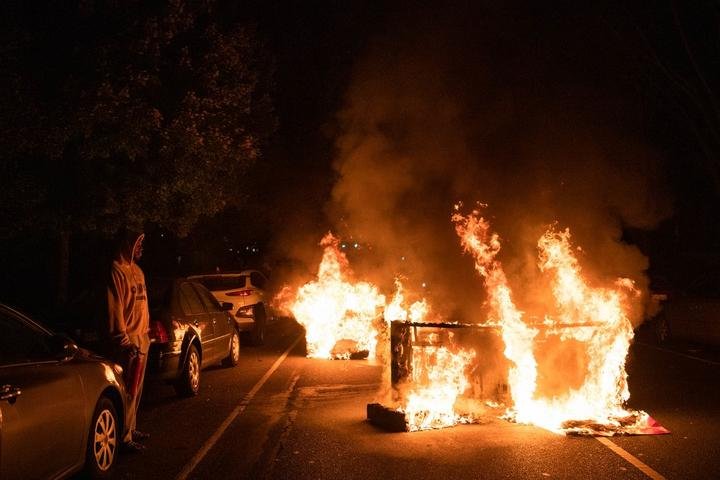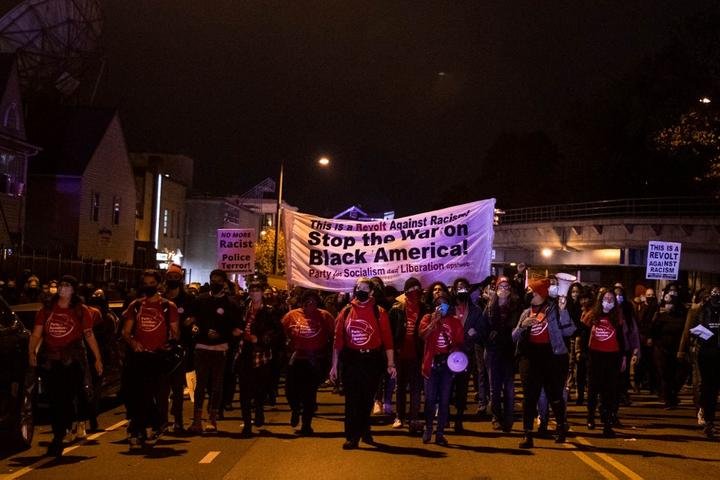Curfew in Philadelphia after police kill black man
A curfew has come into force in Philadelphia after two days of protests and looting following the police killing of a black man.

Police officers congregate an hour before a citywide curfew came into place in Philadelphia on 28 October 2020. Photo: AFP / 2020 Getty Images
The family of Walter Wallace Jr says he was suffering a mental health crisis when he was shot by officers. Police say he had refused to drop a knife.
On Tuesday night, protesters again clashed with police, and barricaded businesses across the city were looted.
The curfew order is citywide and began at 9pm local time.
The Pennsylvania National Guard as well as police reinforcements have been deployed. Authorities say 30 officers were hurt during Monday night’s clashes.
Businesses have been boarding up their windows in fear of another night of violence.
Wallace, 27, had bipolar disorder, and his wife told officers this before they shot him, a lawyer representing his family said.
Philadelphia also saw large protests earlier this year over police brutality and racism following the death of George Floyd in Minnesota.
What happened on Tuesday?
The marches began peacefully on Tuesday but became more confrontational as the evening drew on. Officers in riot gear arrived in squad cars, on bicycles and on buses, and used their bikes to shove protesters back from barricade lines.
Shops around the city closed early and set up barricades. Police and the city’s office of emergency management said widespread looting was reported in several areas.
According to the Philadelphia Inquirer, protesters tried to erect makeshift barricades using bins. Police used pepper spray and batons after saying they had been attacked by demonstrators.
On Monday, more than 300 people took to the streets to protest, and 91 were arrested. One officer was in hospital with a broken leg and other injuries after being struck by a pickup truck.
On Tuesday night, another 81 people were arrested, with 53 of them charged with burglary. Twenty-three officers were injured, officials said.

A demonstration against the fatal shooting of Wallace Walter Jr by police. Photo: AFP
How has it reached the campaign trail?
Speaking at a campaign rally in Wisconsin on Tuesday, US President Donald Trump attempted to tie the protests to his democratic rival, former Vice-President Joe Biden, without providing evidence of a link.
“Last night [Monday] Philadelphia was torn up by Biden-supporting radicals,” he said. “Thirty police officers, Philadelphia police officers, they were injured, some badly. Biden stands with the rioters, and I stand with the heroes of law enforcement.”
On Wednesday, White House Press Secretary Kayleigh McEnany said the riots were “the most recent consequence” of the Democrats “war on police”, and that “mob rule” could never be allowed.
In a joint statement on Tuesday, Biden and his running mate, Kamala Harris, said: “We cannot accept that in this country a mental health crisis ends in death.” They also condemned the looting as a crime.
Speaking briefly to reporters on Wednesday, Biden said: “I think to be able to protest is totally legitimate, totally reasonable. But there’s no excuse for the looting.”
Philadelphia is the largest city in Pennsylvania, a state critical to next week’s presidential election.
Mayor Jim Kenney, a Democrat, said the video of the shooting presented “difficult questions that must be answered”, and that he was looking forward to a “speedy and transparent resolution” to the case.
What do we know about the shooting?
Police said two officers responded to a report of a man with a weapon in the neighbourhood of Cobbs Creek in West Philadelphia about 4pm (local time) on Monday.
Police officials say a man, later identified as Wallace, was holding a knife when the officers approached, and instead of following orders to drop the weapon he “advanced towards them”.
Both officers fired “several times”, hitting Wallace in the shoulder and chest, she said. One of the officers drove him to a hospital, where he was pronounced dead, police say.
Footage shared on social media shows two officers pointing their guns at Wallace as he walks towards them. The officers back away from him and shout at him to put the knife down. Shots are then fired and Wallace is seen lying on the street.
Wallace’s father told the Philadelphia Inquirer that his son had mental health issues and was on medication. “Why didn’t they use a Taser?” he asked.
At Tuesday’s news conference, officials said the officers both fired seven shots each. The officers, who have not been named, were wearing body cameras and did not carry Tasers.
Philadelphia Police Commissioner Danielle Outlaw said the city was conducting a “threat assessment” to determine “if and when” to release the officer names without putting their safety at risk.
Meanwhile, Wallace’s family lawyer said they had called for an ambulance – not police – to help deal with Walter Wallace’s mental issues. Instead, two police officers arrived, lawyer Shaka Johnson was quoted as saying by the Inquirer.
Wallace’s pregnant wife told them her husband had bipolar disorder and was in crisis.

Protesters march through West Philadelphia on 27 October. Photo: AFP
Who was Walter Wallace?
Wallace was an aspiring rapper, and often recorded songs on issues including gun and police violence and racial injustice, according to relatives and neighbours, who described him as a “quiet, family man”.
The Inquirer reported he was a father of eight who had been in and out of court throughout his adult life. He was awaiting trial for allegedly making threats, but this had been delayed repeatedly because of the coronavirus pandemic.
He pleaded guilty to robbery, assault and possessing an instrument of crime in 2017 after kicking down a woman’s door and putting a gun to her head, Philadelphia’s ABC affiliate WPVI reports. He was sentenced to 11-23 months behind bars, with a judge requiring mental health supervision.
In 2013, he pleaded guilty to assault and resisting arrest after punching a police officer in the face, the broadcaster reported, saying that a judge had ordered him to undergo psychiatric evaluation and treatment.
“I do know that he was on a regimen of lithium and that says to me he was under a doctor’s care,” the family lawyer said after the shooting, citing a medicine used in the treatment for conditions including bipolar disorder.
– BBC
